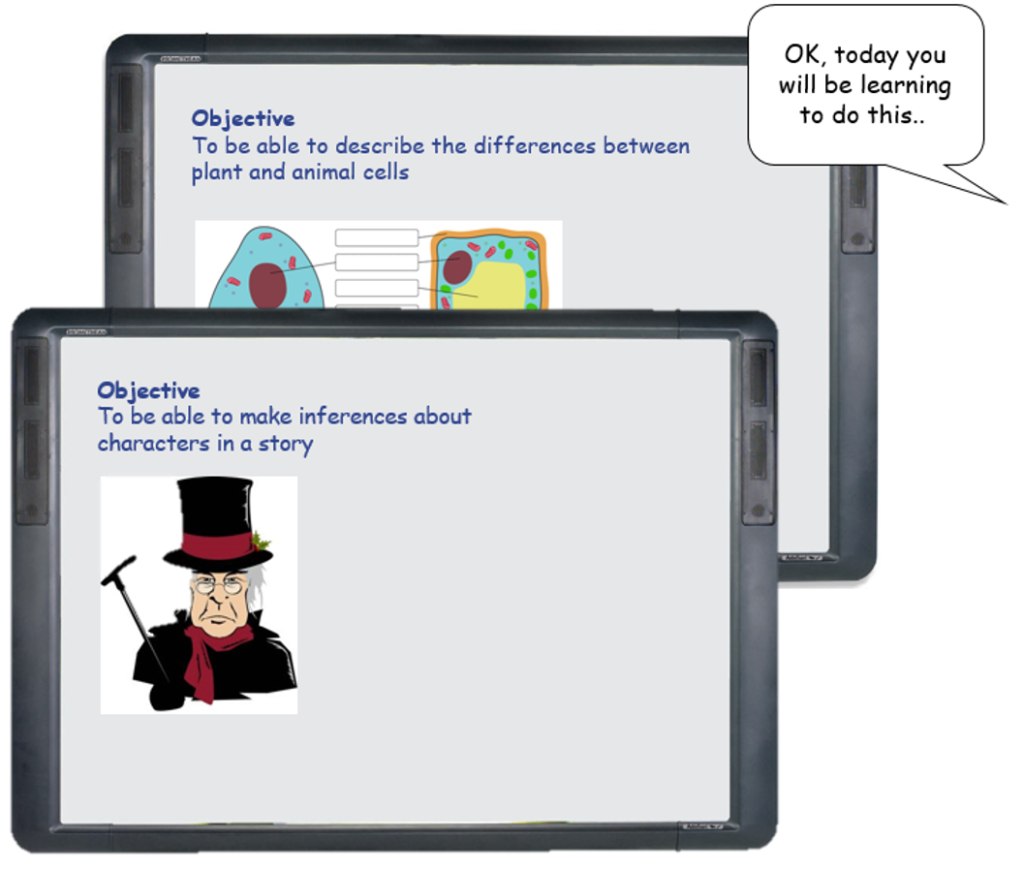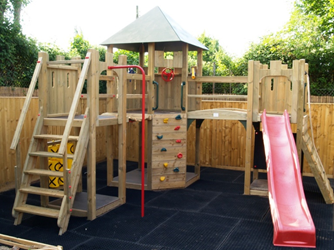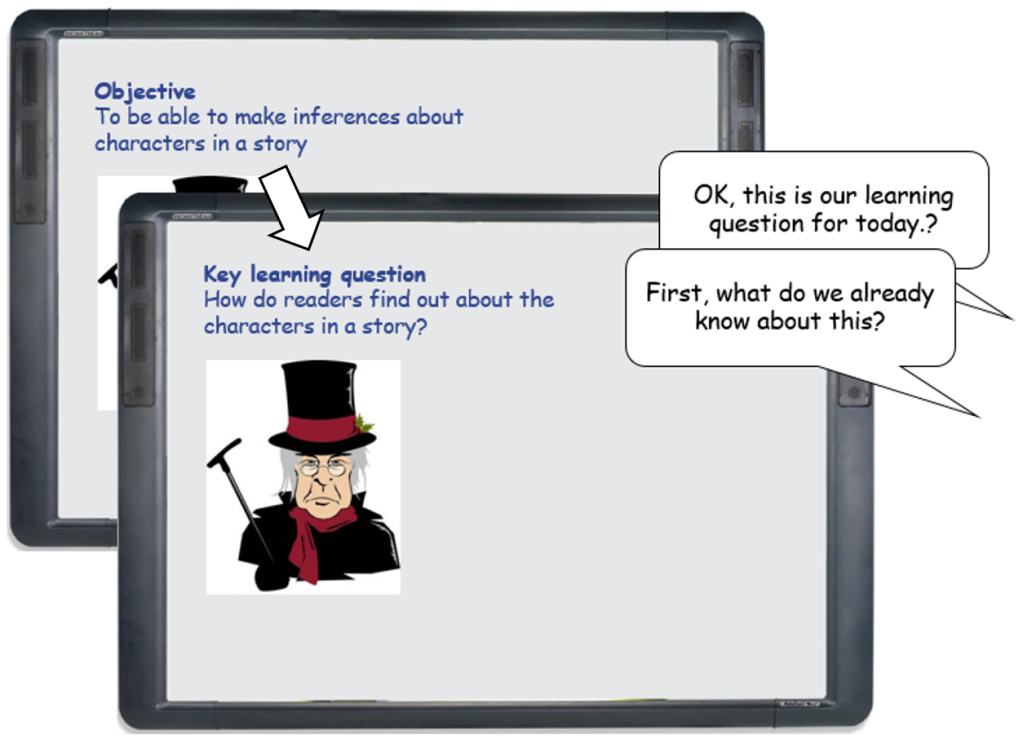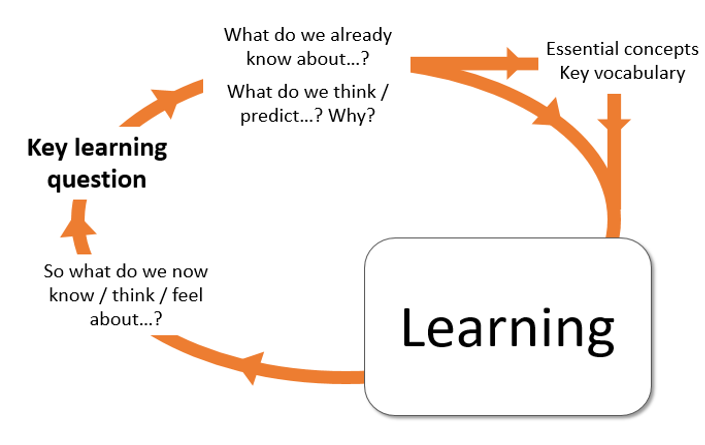A ‘key learning question’ is simply a way of framing the learning in a lesson or across a sequence of lessons – of setting the learning agenda for pupils. It is an alternative to the traditional ‘learning objective’, replacing a statement of what pupils will learn, or of what they will aim to learn, with a thought-provoking question, which the teaching and the learning will then address or try to answer.
This post was written in response to requests from schools for a simple introduction to their use. Any corrections, criticisms or suggestions are very welcome!
Traditional ‘learning objectives‘
Typically, learning objectives shared with pupils at the start of a lesson have been designed to make very clear what it is expected will be learned in that lesson.

There are several risks with this. Arguably, it is a sort of spoiler – it takes away any engaging mystery or suspense. More importantly, it is potentially narrowing: this is – by implication – all that has to (or will) be learned. And it is potentially suppressing of attainment: this is as far as it is necessary to go or to think. It can be unambitious – unchallenging. What else might pupils learn or become better able to do? What might some attain to? Where else might the learning go?
It risks putting the learning in a box, with the lid taped down.

One way around this has been the ‘differentiated objective’. And this, of course, has lots of other problems. The different goals are artificial and often arbitrary. And there is really no reason at all why ALL pupils shouldn’t be able to do ALL of these things, at some level.

This kind of objective setting is still about the limiting, rather than the opening up, of possibility. It just puts each pupil into one of several boxes.
It is the opposite of the ‘pitch high and scaffold’ approach, by which all pupils at least aspire to reach the same ‘height’, but with different scaffolding – through the teacher’s responsive questioning, explanations, feedback, modelling and material support.

The idea of key learning questions is that they are a way to keep such possibility open for all. They can be an engine of challenge for all pupils, not just for those already attaining highly.
Key learning questions as an engine of challenge in the classroom
Often, objectives are simply turned around into question form. The trouble with this is that it is no less limiting. There is no more possibility implied.

In this case, the binary ‘yes’ or ‘no’ invites a full stop to learning: some pupils might believe that they can; others that they can’t.
This next question is more open. It will be easier to create some buzz in the classroom with this. Now there is at least some sense of enquiry.

Of course, in this example it’s still just another way of announcing the knowledge – of promising some factual information. It doesn’t yet provide pupils with anything to think hard about.
Often, this will be a pragmatic compromise – a way to begin with a suggestion of enquiry and of disciplinary thought, but with enough clarity and security to drive the pace of learning.
However, it is always exciting to see a question like this next one on a board.

This keeps the question very open. Answering this will still require an understanding of HOW plant and animal cells are different, but it reaches beyond this to WHY.
The discussion might now extend to evolutionary questions (How did they come to be different?) as well as functional questions (What different things do they do?)
It also has a sharper sense of enquiry – something almost philosophical. It invites hard thinking – scientific thinking, perhaps. This lesson can start with an engaging discussion, with wondering and hypothesising.
Most importantly, there is no lid on the learning in this lesson. All tangents and extensions are possible. There is no set limit to the challenge.

Similarly, in this English lesson, being ‘able to make inferences’ would still be a key part of a lesson framed by the question ‘How do readers find out about the characters in a story?’ But now the scope is much broader. Possibilities for learning are open, not narrow.

And now there is some challenge: after all, pupils have always been able to make inferences about characters.
Importantly, the lesson starts with something to think hard about – with a question of disciplinary knowledge that is genuinely interesting, for pupils and for teacher.
It now becomes natural to begin with a discussion of prior knowledge, which also pushes at the edges of that knowledge.

The key learning question can be a simple but effective engine of challenge, driving hard thinking in the lesson and promoting a culture of enquiry.
Key learning questions as an organising device in lessons
By providing both a natural stimulus to begin learning and then a natural way to review learning afterwards, the key learning question is a satisfying framing device for a lesson. What are we trying to answer? What do we know about this already? What essential concepts or terms might need establishing straight away? Then, at the end of the lesson: are we able to answer the question? Of course, this cycling round may be ongoing throughout the lesson, as the question is explicitly or implicitly revisited.

Some variants on the key learning question
For teachers, it can be fun inventing the right key learning question to drive a lesson, or to form an overarching line of enquiry for a sequence of lessons or for a whole topic It is a search for varied and powerful ways to stimulate thinking, to engage the imagination and to demand attention.
A provocation in music: Why does reggae exist? (Thanks to @Johnfinney8)
A ‘weighing up’ question in business studies: What are the risks and rewards of starting up a business? (Thanks to @sue_farrimond)
An hypothesis in geography: ‘The vast majority of the worlds population lives somewhere in the middle of the income scale.’ True or false? (Thanks to @m_chiles)
A clever cultural reference in geography: Do they know it’s Christmas? (Thanks to @wychwoodgeog)
A playfully-worded but fertile question in geography: Does wealthier mean healthier? (Thanks to @mildthing99)
Key questions and disciplinary thinking
Often, key learning questions are a way explicitly to relate learning to particular disciplinary practices and ways of thinking.
Enquiry, evaluation and philosophy in RE: Why do Christians disagree about the Eucharist? / How significant was the Sunni/Shia split? / What is the impact of believing nothing is determined? / Does your phone think? (Thanks to @PhilosophyEllie)
There is a well-established tradition of this in history teaching, with the use of ‘enquiry questions’.
Exploring a ‘first order concept’: What did ‘revolution’ mean in the Age of Revolution?
Exploring a ‘second order concept’: Why did the British Empire end?
Covering a topic or theme in breadth: To what extent have women achieved equality since 1918?
Delving into a narrower concept in depth: Why do historians still disagree about why people went on the first crusade?
Unlocking a rich and powerful sense of period: What change could the Victorian poor see?
(Thanks to @histassoc)
These ‘enquiry questions’ in history often seek to problematise knowledge in different ways:
A question about causation: Why did Revolution break out in France in 1789?
A question about change: What difference did the French Revolution really make?
Thanks to @MrMountstevens
Key learning questions and prior disciplinary knowledge
Of course, it is also important to think about the relationship between a key learning question and pupils’ prior learning in the discipline.
Do we pose questions in a way which invokes a sense of natural wonder – in a way which emphasises natural curiosity – like these?
Why are some villages clumpy and some long and stringy?
Why do rivers sometimes suddenly flow faster nearer the sea?
Or do we frame them in a more geography-ish way, using the language of the discipline?
Which influences result in linear and nuclear settlements?
What causes rejuvenation in rivers?
And it may well be that this depends on prior disciplinary knowledge, and the extent to which we want pupils to see themselves and to operate as experts rather than as novices.
And so the wording of questions may reflect, and help to map, the journey of pupils as they make progress through the curriculum – from novice to expert, from naïve to knowing, from lay learner to disciplinary specialist.
Importantly, this journey might happen in the course of a single lesson, as the question is answered using the language of the discipline.
Mark Enser puts it like this. “We start from the child’s perspective and then move to ‘And how would a geographer approach this?’ That is when we know our curriculum is working.” @EnserMark
‘Fertile questions’
In ‘Teaching and Learning in a Community of Thinking’ (2005) Yoram Harpaz develops the idea of teaching disciplinary thinking through what he calls ‘fertile questions’. In a series, such questions can provide structure and organisation to the curriculum.
Harpaz suggests six criteria for ‘fertile questions’, and these may be useful for thinking about key learning questions generally. Many of the examples above might be seen as ‘fertile’ in these terms.
Making questions fertile: six criteria
- Open: there is no simple ‘yes’ or ‘no’ answer. There will be several, possibly contradictory answers, which can be debated.
- Undermining: requires new ways of thinking and challenges assumptions or ‘common sense’ thinking.
- Rich: requires engagement with important knowledge about the world, which may need extensive research
- Connected: links to other parts of the discipline, as well as pupils’ everyday knowledge
- Charged: has a strong ethical or emotional dimension, which will motivate pupils’ thinking and investment
- Practical: there must be the possibility of pupils actually answering the question, through teaching and research
Mark Enser outlines very persuasively how ‘fertile questions’ can work in geography, in an article for the TES here.
Summary
Key learning questions can …
… help to create a classroom culture of enquiry
… keep learning open, avoiding narrowness, limits and ceilings
… provide challenge for all pupils
… promote hard thinking
…engage and stimulate
… prompt retrieval of prior knowledge at the start of lessons
… provide a natural point of reflection during and at the end of lessons
… teach disciplinary thinking
Some key questions about key questions, for subject leaders
- How can key learning questions work to generate challenge and engagement in your subject?
- How can they help to teach disciplinary or domain-specific thinking in your subject?
- What forms might they take in lessons?
- Might the process of inventing and reviewing them be powerful CPD for a subject team?
- Can they be written into curriculum plans, as a way of foregrounding key concepts, of mapping the development of disciplinary understandings, and of encoding challenge?
See also Objectives and purpose in English

Nice one
G x .
LikeLike
Thoroughly enjoyed reading this and it’s provided lots of helpful guidance
LikeLike